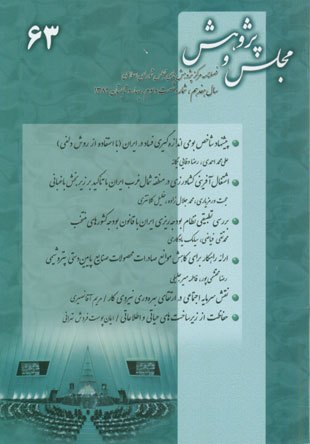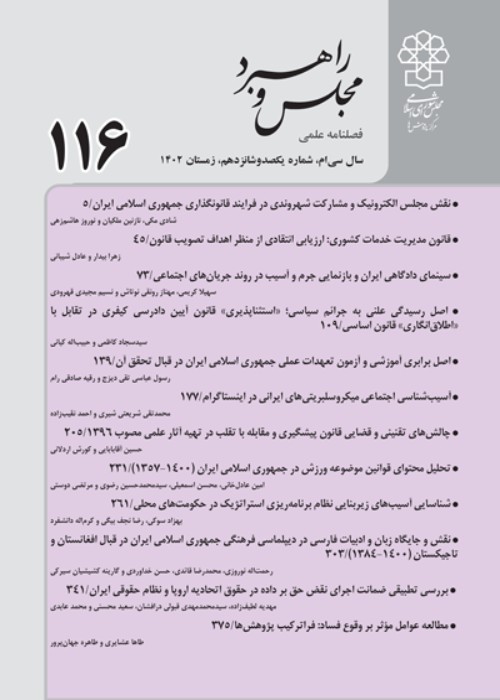فهرست مطالب

فصلنامه مجلس و راهبرد
پیاپی 63 (بهار و تابستان 1389)
- 178 صفحه، بهای روی جلد: 15,000ريال
- تاریخ انتشار: 1390/04/10
- تعداد عناوین: 7
-
صفحه 5
-
Page 7The paper's objective is to present local indicators for measuring corruption in Islamic Republic of Iran. Therefore, the strengths and weaknesses have been considered by studying current indicators of corruption measurement. So variations are proposed to measure corruption in International research. Afterwards, the paper attempts touse six indicators to measure Iranian corruption among them by using elite's comments and Delphi study as follows: The government size, Jinni coefficient, wages, number of independent newspaper, regulatory quality, and informal economy.
-
Page 41According to the necessity of the reduction of peasant's irregular migration, employment creation in rural areas is a vital, especially in areas where is so densely rural populated and suitable for agricultural activities too. The paper's main objective is to study the situation of rural employment creation in northwest region of Iran (including East and West Azerbaijan provinces, Ardabil and Zanjan) and finding solutions to this problem. Therefore, some of the most important economic and demographic characteristics and common feature of agricultural sector of this region were discussed and compared with thenational average. The study is based on Census data of Iranian Statistical Center Yearbooks, Iranian Central Bank and Management and Planning Organization Reports. The data were studied by SPSS & GIS softwares analytically-descriptively. Results show that 31.39 percent of Iranian population lives in rural areas that its average for the northwest region is 37.66 percent. According to the calculated composite index, economically, Iranian northwest agricultural sector is more active than other Iranian regions. Also, in spite of the fact that about 23 percent of value added of this region is obtained fromagricultural sector (that the figure is only 11 percent of the total of Iranian population) as well as 34 percent of this region's population engage in agricultural activities, Iranian agricultural labour productivity especially in northwest provinces is low and there is an obvious latent unemployment phenomenon in this region. According to the findings,we can prepare the good way for productive rural employment creation by transferring surplus agricultural labor from the agronomy sub sector to the horticultural sub sector, the establishment of greenhouse complexes in mid-term, and the development of processing industries pertaining to horticultural in long-term.
-
Page 71During last decades, Iranian budgeting system has been changed neither structurally and functionally nor legally. Whereas according to the constitution and the forth development plan, drafting of budget law and changing Iranian budgeting system have been so necessary. Iranian budget and plan law ratified in 1972 cannot be fulfilled the requirements of Iranian budgeting system during about four decades and it should beamended and updated. The Iranian budgeting system has many problems in different fields such as the interference of the executive and the legislative power's responsibilities for budgeting system, drafting of budget law on the basis of administration's status quo instead of the state's assigned duties, only drafting of financial budget laws rather thanoperational-financial budgets, focusing on budgeting system but lack o the necessary structures to establish operational budgeting system. Finally, it is concluded that most of these problems are removed by the enactment of law and the amendment of Iranian budgeting laws.
-
Page 93Statistical analyses show that petrochemical industry products are the most significant options of Iranian non-oil exports. The production of these products lengthens value added of oil and gas hydrocarbon nonrenewable resources and substances. The importance of petrochemical products subject needs more studies. The paper discusses the circumstances of petrochemical final industries exports that they are much more effective on national economy development. Therefore, petrochemical final industries exports have been compared with non-oil and industrial exports from 2000 to 2007. In spite of the growth of petrochemical final industries products exports, there are several gaps between Iranian petrochemical industries exports and non-oil andindustrial exports. Also the paper studies impediments to petrochemical final industries exports descriptively and it finds solutions to improve the status quo. According to the analyses, the lack of an integrated strategy and a proper planning for the development of Iranian petrochemical industry, the lack of comprehensive organizations, inaccessibility of necessary infrastructures, the purposelessness of government supports and export incentives, and low quality of products in some cases are known as serious impediments to the development of Iranian petrochemical final industries products exports. Finally, solutions have been found to develop petrochemical final industries exports.
-
Page 111The paper discusses the effect of social capital on Iranian labour productivity. Descriptive-analytical study is used for the paper by gathering library and documentary data. So the first, social capital is defined and its measurement methods are discussed as well as the status of social capital is explained by the statutory and formal documents.Therefore, the trend of social capital and labour productivity and the effect of social capital on labour productivity process are analyzed. Consequently, the findings show that social capital has dramatic effect on labour productivity.
-
Page 139Emerging information era, different fields are confronted with extensive security challenges beyond the warfare. Vastly growth of Internet economy has created a new aspect in commerce that it has put the internet industries in a very vulnerable position. Internet economy, information security, structural dependence, and new approach toprotect them, especially information infrastructures have been appeared as well.Information warfare is a kind of the conflict that it attacks rival's beliefs or knowledge or his/her information systems directly that it can be used as a part of a bigger or more comprehensive than the cyber war or as a separate part of them. Therefore, different aspects of information warfare and its functions to counter security and critical informationinfrastructures as well as information growth should be recognized remarkably so that it can be known as protective priorities of the new era. The protection of main parts of private and government information infrastructures is impossible unless communication industry is regularized, private and government sectors cooperate with each otherand protective priorities of information infrastructures are taken into account as well.


